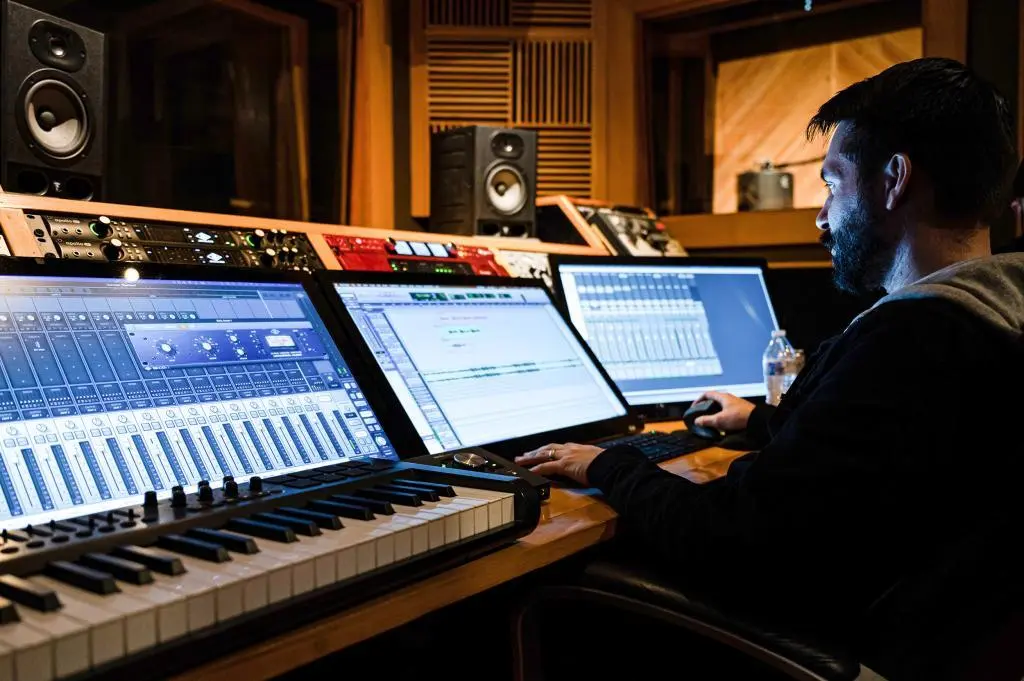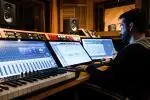Digital Signal Processing (DSP) is the methodical manipulation of audio signals in a digital environment.
It involves taking real-world, continuous audio signals, converting them into a digital format, and then applying specific mathematical procedures to modify or enhance these signals. This transformative process is at the heart of modern audio engineering, enabling professionals to craft sound with unparalleled precision and clarity.

What is DSP (Digital Signal Processing): Table of Contents
DSP: The Science Behind Sound Manipulation
At its core, DSP is about understanding and altering the very essence of sound. In the vast realm of audio, where every nuance matters, DSP provides the tools to sculpt, mold, and refine sound to perfection. Whether it’s removing unwanted noise, emphasizing certain frequencies, or creating entirely new soundscapes, DSP empowers audio professionals to manipulate sound in ways that were once thought impossible. It’s the bridge between raw audio and the polished sound that resonates from our speakers, headphones, and live stages.
From Real-World Sounds to Digital Masterpieces
The journey of a sound wave, from its origin to its digital representation, is a marvel of modern engineering. Initially, when a sound is produced—be it a strum of a guitar, a vocalist’s melody, or the ambient sounds of nature—it exists in an analog form. This continuous waveform is then captured by microphones and converted into a digital format through a process called Analog-to-Digital Conversion (ADC). Once in this digital realm, Digital Signal Processing takes over. With the power of DSP, these digital signals can be enhanced, modified, or even transformed, turning simple sounds into intricate audio masterpieces. It’s this journey, from real-world ambiance to digital artistry, that showcases the true magic of DSP in the world of audio.
In the ever-evolving landscape of audio production, Digital Signal Processing stands as a testament to human ingenuity, bridging the gap between natural sound and digital perfection. For anyone seeking to understand the intricacies of modern sound, DSP is the key that unlocks a world of sonic possibilities.
The Evolution of DSP in the World of Music and Audio
The world of music and audio has witnessed revolutionary changes over the decades, and at the heart of this evolution lies Digital Signal Processing (DSP). From the raw, organic sounds of the analog era to the crisp, refined audio of today, DSP has played a pivotal role in shaping the soundscape of modern music production.
How Has DSP Shaped Modern Music Production?
The Analog Era vs. The DSP Revolution
The analog era, with its vinyl records and tape machines, had a charm of its own. The warmth and richness of analog sound are often nostalgically revered by audiophiles and music enthusiasts. However, analog systems had their limitations. They were susceptible to noise, wear and tear, and lacked the flexibility to manipulate sound extensively.
Enter Digital Signal Processing. With the advent of DSP, the music industry experienced a seismic shift. Suddenly, audio could be manipulated with a precision and versatility that analog systems couldn’t match. Noise could be reduced to near imperceptible levels, frequencies could be adjusted with pinpoint accuracy, and entirely new sounds could be synthesized from scratch. The DSP revolution didn’t just enhance audio quality; it expanded the very horizons of what was possible in music production. While analog gave us the raw essence of sound, DSP provided the tools to mold that essence into any form imaginable.
Milestones in DSP: Key Developments Over the Years
The journey of Digital Signal Processing in music and audio is marked by numerous milestones that have redefined the industry:
- Introduction of Digital Audio Workstations (DAWs): The birth of DAWs revolutionized music production, allowing artists and producers to craft, edit, and mix music all in a digital environment powered by DSP.
- Real-time Audio Effects: DSP enabled the application of real-time effects like reverb, delay, and compression, transforming live performances and studio recordings alike.
- Advanced Equalization: With DSP, equalization became a precise art, enabling sound engineers to adjust frequencies with unparalleled accuracy.
- Noise Reduction and Restoration: DSP techniques made it possible to restore old recordings, removing clicks, pops, and hisses, breathing new life into classic tracks.
- Spatial Audio and 3D Sound: DSP paved the way for innovations in spatial audio, creating immersive soundscapes that envelop the listener.
The evolution of Digital Signal Processing in the world of music and audio is a testament to human innovation and creativity. From the nostalgic notes of the analog era to the digital symphonies of today, DSP has been the silent maestro orchestrating a revolution in sound. As we look to the future, one thing is certain: DSP will continue to shape the sonic landscapes of tomorrow, pushing the boundaries of what’s possible in music and audio.
DSP in Action: Applications in Professional Audio
In the vast realm of professional audio, Digital Signal Processing (DSP) stands as a beacon of precision, innovation, and quality. Its applications are manifold, touching every facet of music production, from the intimate confines of a recording studio to the grandeur of live stage performances. Let’s delve into how DSP has become an indispensable tool in the world of music production.
Where Does DSP Come Into Play in Music Production?
Crafting Crystal-Clear Tracks: DSP in the Studio
The recording studio is a sanctuary for artists, a place where raw talent meets technology to birth musical masterpieces. At the heart of this synthesis lies DSP. When an artist lays down a track, it’s DSP that ensures the recording is free from unwanted noise and interference. Whether it’s the subtle nuances of a vocalist’s timbre or the intricate details of an acoustic guitar, DSP works meticulously to capture every sound with clarity and precision.
Beyond mere recording, Digital Signal Processing plays a pivotal role in mixing and mastering. It allows sound engineers to sculpt and shape the audio, enhancing certain frequencies, attenuating others, and adding effects to achieve the desired sonic texture. With DSP, tracks are not just recorded; they are crafted, molded, and perfected, ensuring that what listeners hear is a crystal-clear representation of the artist’s vision.
Live Performances Elevated by DSP
The magic of live performances is undeniable. The energy, the connection between the artist and the audience, the raw emotion – it’s an experience like no other. And ensuring that this experience is sonically impeccable is DSP. In live settings, challenges abound. There’s ambient noise, the risk of feedback, and the need to balance various instruments and vocals in real-time. DSP rises to the occasion, processing audio signals on-the-fly to deliver clear, feedback-free sound.
Moreover, Digital Signal Processing allows for real-time effects and modifications. Whether it’s adding reverb to a singer’s voice, enhancing the bass during a drop, or creating spatial soundscapes that envelop the audience, DSP is the silent hero behind the scenes. It ensures that the sound emanating from the speakers is as mesmerizing as the performance on stage, creating an immersive audio experience that lingers long after the concert is over.
The Techniques and Algorithms Behind DSP
Digital Signal Processing (DSP) is more than just a buzzword in the audio industry; it’s the intricate blend of science, mathematics, and art that ensures every sound we hear in a digital format is of the highest quality. But how does DSP achieve this level of perfection? Let’s delve into the techniques and algorithms that make this possible.
How Does DSP Achieve Audio Perfection?
The Mathematics of Sound: DSP Algorithms
At the heart of Digital Signal Processing lies a series of mathematical procedures and algorithms. These algorithms are designed to manipulate digital signals in various ways, ensuring optimal sound quality. Some of the core mathematical techniques include:
- Fourier Transforms: This technique breaks down a signal into its constituent frequencies, allowing for precise frequency-based manipulations.
- Filtering: Using various filters, DSP can emphasize or attenuate specific frequency ranges, ensuring that unwanted noises are minimized while desired sounds are highlighted.
- Convolution: A complex mathematical operation that allows for the superimposition of one signal over another. This is especially useful in creating reverb and other spatial effects.
- Adaptive Algorithms: These are designed to adjust in real-time based on the input signal, ensuring dynamic sound optimization.
The beauty of DSP algorithms is their ability to work in tandem, combining their individual strengths to process audio signals in ways that were once thought impossible. It’s this intricate dance of mathematics and sound that ensures DSP’s unparalleled audio perfection.
Real-World Applications: DSP Techniques in Use
In the realm of music production and audio engineering, DSP algorithms are not just theoretical concepts; they’re practical tools that shape the soundscapes we immerse ourselves in. Some real-world applications include:
- Equalization: Using DSP’s filtering techniques, sound engineers can adjust the balance of different frequency components, ensuring that each instrument and vocal shines through in a mix.
- Noise Reduction: Through adaptive algorithms, DSP can identify and minimize unwanted ambient noises, ensuring crystal-clear recordings and playback.
- Reverb and Spatial Effects: Using convolution and other techniques, DSP can simulate various acoustic environments, from the echo of a grand cathedral to the intimacy of a small room.
- Dynamic Range Compression: DSP algorithms can automatically adjust the volume of audio signals, ensuring that quiet parts are audible while preventing louder sections from distorting.
The Future of DSP in Music and Audio
As we stand on the cusp of a new era in audio technology, Digital Signal Processing (DSP) promises to play an even more pivotal role in shaping the future soundscape. The relentless march of technological progress ensures that DSP will continue to evolve, bringing forth innovations that will redefine our auditory experiences.
What’s on the Horizon for Digital Signal Processing?
Emerging Trends and Innovations in DSP
The world of DSP is abuzz with potential breakthroughs that could further revolutionize the audio industry. Some of the anticipated trends and innovations include:
- Enhanced Real-time Processing: As computational power continues to grow, real-time DSP operations will become even more efficient, allowing for instantaneous audio manipulations with zero perceptible lag.
- Advanced Acoustic Modeling: Future DSP algorithms might be capable of simulating even more complex acoustic environments, enabling sound engineers to recreate any desired auditory setting with uncanny accuracy.
- Personalized Audio Experiences: With the rise of personalized tech, DSP could tailor audio experiences to individual listeners, adjusting sound profiles based on personal preferences or even physiological responses.
- Eco-friendly DSP Solutions: As sustainability becomes a global priority, we might see the development of DSP algorithms optimized for energy efficiency, ensuring top-tier audio processing with a minimal carbon footprint.
The Convergence of DSP and Emerging Technologies
The future of Digital Signal Processing is not just about its own evolution but also its integration with other cutting-edge technologies. Some potential convergences include:
- DSP and Artificial Intelligence (AI): AI could enhance DSP by automatically optimizing audio signals based on machine learning algorithms. Imagine a system that learns from your listening habits and automatically adjusts audio parameters for the optimal listening experience.
- Spatial Audio and Augmented Reality (AR): As AR becomes more mainstream, DSP will play a crucial role in creating spatial audio experiences that complement visual AR elements, immersing users in a multi-sensory environment.
- DSP in Quantum Computing: While still in its infancy, the potential integration of quantum computing with DSP could lead to processing speeds and efficiencies previously deemed impossible.
- Bio-integrated DSP: Future innovations might see DSP algorithms that can interface directly with our neural systems, paving the way for audio experiences directly streamed to our brains, bypassing traditional auditory pathways.

